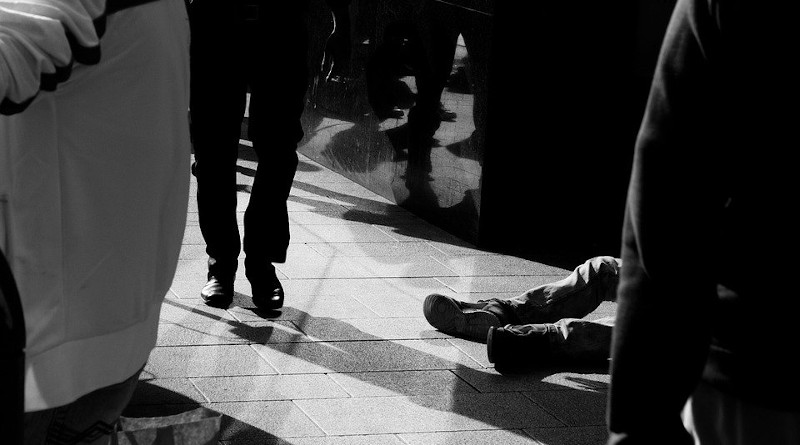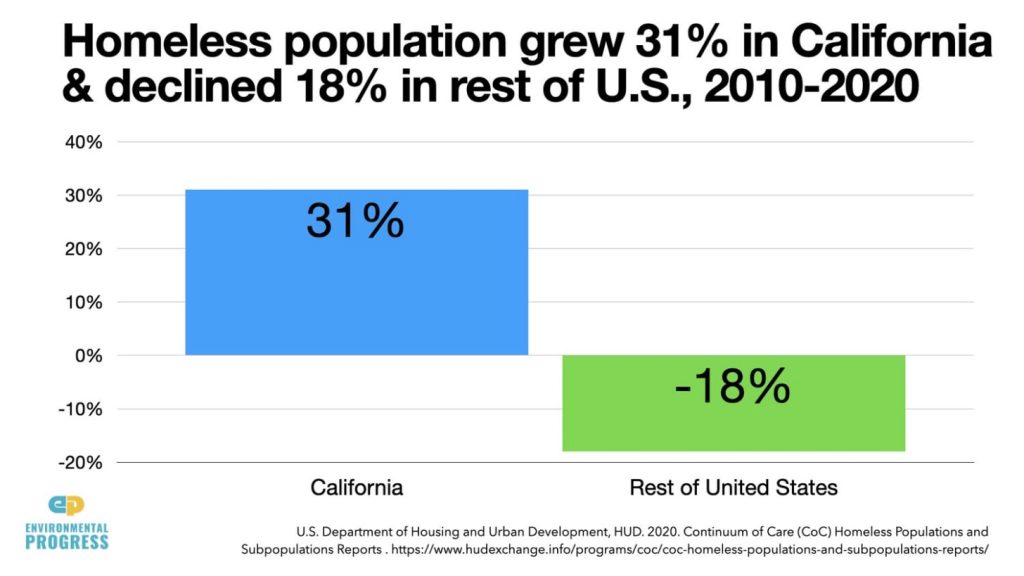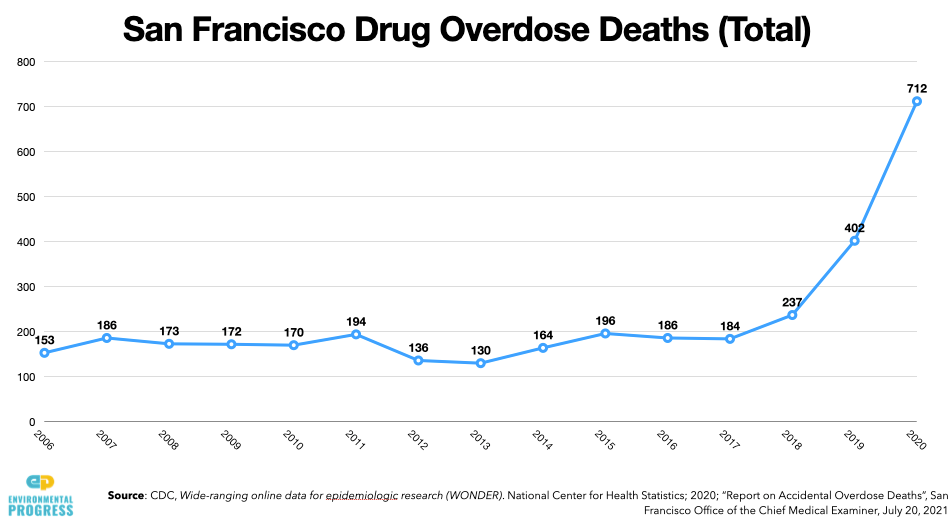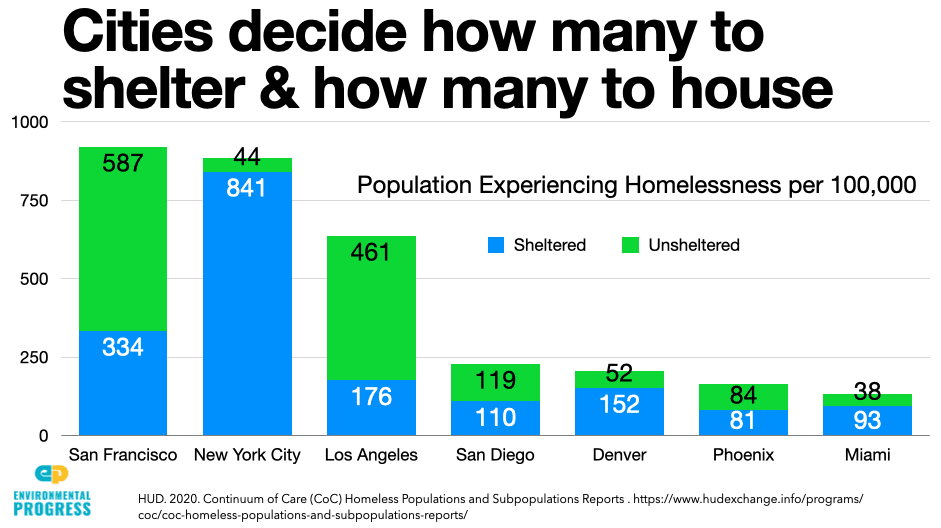San Francisco Homeless Insider Tells All – OpEd
In my new book, San Fransicko, I describe why progressives create and defend what European researchers call “open drug scenes,” which are places in cities where drug dealers and buyers meet, and many addicts live in tents. Progressives call these scenes “homeless encampments,” and not only defend them but have encouraged their growth, which is why the homeless population in California grew 31 percent since 2000. This was mostly a West Coast phenomenon until recently. But now, the newly elected progressive mayor of Boston, Michelle Wu, has decided to keep open a drug scene at Mass and Cass avenues, even though it has resulted in several deaths from drug overdoses and homicides.
Progressives defend their approach as compassionate. Not everybody who is homeless is an addict, they say. Many are just down on their luck. Others turn to drugs after living on the street. What they need is our help. We should not ask people living in homeless encampments to go somewhere else. Homeless shelters are often more dangerous than living on the street. We should provide the people living in tents with money, food, clean needles, and whatever else they need to stay alive and comfortable. And we should provide everyone with their own apartment unit if that’s what they want.
But this “harm reduction” approach is obviously failing. Cities already do a good job taking care of temporarily homeless people not addicted to drugs. Drug dealers stab and sometimes murder addicts who don’t pay. Women forced into prostitution to support their addictions are raped. Addicts are dying from overdose and poisoning. The addicts living in the open drug scenes commit many crimes including open drug use, sleeping on sidewalks, and defecating in public. Many steal to maintain their habits. The hands-off approach has meant that addicts do not spend any amount of time in jail or hospital where they can be off of drugs, and seek recovery.
Now, even a growing number of people who have worked or still work within the homeless services sector are speaking out. A longtime San Francisco homeless service provider who read San Fransicko, and said they mostly agreed with it, reached out to me to share their views. At first this person said they wanted to speak on the record. But as the interview went on, and the person criticized their colleagues, they asked to remain anonymous, fearing retribution.
Why “Housing First” Failed
The main progressive approach for addressing homelessness, not just in San Francisco but in progressive cities around the nation, is “Housing First,” which is the notion that taxpayers should give, no questions asked, apartment units to anyone who says they are homeless, and asks for one. What actually works to reduce the addiction that forces many people onto the streets is making housing contingent on abstinence. But Housing First advocates oppose “contingency management,” as it’s called, because, they say, “Housing is a right,” and it should not be condition on behavior change.
But such a policy is absurdly unrealistic, said the San Francisco homeless expert. “To pretend that this city could build enough permanent supportive housing for every homeless person who needs it is ludicrous,” the person said. “I wish it weren’t. I wish I lived in a land where there was plenty of housing. But now people are dying on our streets and it feels like we’re not doing very much about it.”
The underlying problem with Housing First is that it enables addiction. “The National Academies of Sciences review [which showed that giving people apartments did not improve health or other life outcomes] you cited shows that. San Francisco has more permanent supportive housing units per capita than any other city, and we doubled spending on homelessness, but the homeless population rose 13%, even as it went down in the US. And so we doubled our spending and the problem got worse. But if you say that, you get attacked.”
How did progressives, who claim to be evidence-based, ever get so committed to Housing First? “Malcolm Gladwell’s [2006 New Yorker article] “Million Dollar Murray,” really helped popularize this idea,” the person said. “But it was based on an anecdote of one person. It works for who it works for but is not scalable. [Governor] Gavin [Newsom] made a mistake [as San Francisco’s Mayor 2004-2011] which was that we stopped investing in shelter. But that’s because all the best minds were saying, ‘This is what’s going to work.’”
One of the claims made defenders of the open drug scenes is that people who live in them are mostly locals who were priced out of their homes and apartments and decided to pitch a tent on the street. In San Fransicko, I cite a significant body of evidence to show that this is false, and that many people come to San Francisco from around the U.S. for the city’s unusually high cash welfare benefits, free housing, and tolerance of open drug scenes.
The insider agreed. “People come here because they think they can. It’s bullshit that ‘Only 30 percent [of homeless] are from out of town.’ At least 20,000 homeless people come through town every year. Talk to the people on the street. There’s no way 70 percent of the homeless are from here. Ask them the name of their high school and they guess, ‘Washington? The one around the corner?’ But you can’t even talk about that without being called a fascist.”
The people living on the street suffer from serious addiction, this person said. “During the first point in time count [census of homeless population] in 2007, one-third had a disability, mental illness, or addiction, while last time, it was over two-thirds. The population fundamentally changed, whether from the drugs, or the time on the street. It doesn’t matter because a lot of the problems on the street are drugs-related. Neither San Francisco nor any other municipality can solve the housing policy without changing federal policy.”
Life in the open drug scenes is brutal, this person confirmed. “Most homeless encampments are not communities but have paper-thin relationships based on their disease. It’s hard to have healthy relationships when you’re just trying to keep your head above water because you’re so dope dependent.”
What San Francisco and other progressive cities are doing isn’t working. “People in those encampments have food brought to them, port-a-potties brought to them, and all they need to do is put drugs in their arm all day. They get really really sick and they die. Portugal didn’t make it so you can do whatever you want. The consequences of your action are treatment driven, but there are consequences. Here there are no consequences. And so we make it worse.”
This person was harshly critical of San Francisco’s Department of Public Health for allowing drug overdoses to rise to over 700 per year. “They say, ‘It’s not our fault because it’s fentanyl.” But it’s only gotten worse.”
This person stressed they were in favor of harm reduction policies like giving addicts clean needles in exchange for them giving back dirty ones, but not just giving out needles. “I’m all in favor of needle exchange, but not of needle distribution. Ask people to return the needles they’ve been given. There are people who don’t have it together enough. I get that. But when you tell people we’re going to give you whatever you want, to do whatever you want… Sleeping on a sidewalk is a crime. There are things you can’t do. You can’t shoot up on the street. The laws are there for a reason.”
Why Progressives Create Homelessness
Open drug scenes look like natural disasters, but they are the result of specific city policies. These policies including giving money, food, and drug paraphernalia to addicts to support their addiction. But even if progressives didn’t give people those things, many addicts would still live in open drug scenes. As such, the main reason “homelessness” is so much worse in progressive West Coast cities is because progressives hotly oppose efforts by cities to close the open drug scenes and move addicts into shelters and rehab.
By blocking the closing of open drug scenes, which is referred to as “clearing an encampment,” people in need of help don’t get it. “The San Francisco Coalition on Homelessness recently [July 2021] protested an encampment clearing where a woman was pregnant,” the insider told me. “As soon as everybody left, the woman went into a shelter, after having been on the streets for three months. She went indoors. It’s like, ‘What are you fighting for? The right of this person to stay on private property and be pregnant?’”
One of the questions I tried to answer in San Fransicko was when it was that street addicts started living in tents. I concluded that it started with the “Occupy Wall Street” protests in 2011, when progressive activists in San Francisco, Oakland, and other cities lived in tents in front of government buildings to protest capitalism. This person confirmed this account. “You’re right that the tents popped up after Occupy,” they said. “But it wasn’t just that the Occupy activists gave the homeless their tents. It was that the homeless saw well-heeled whites sleeping in tents. It got moralized.”
The most influential homeless advocate in San Francisco, and perhaps the United States as a whole, is the head of the San Francisco Coalition on Homelessness, Jennifer Friedenbach. Over the last three decades, Friedenbach has taken control over San Francisco’s homelessness budget and other policies. She blocks the closure of open drug scenes, calls people who disagree with her fascists and racists, and organizes protests at the homes of politicians.
A typical example of Friedenbach’s tactics could be seen in posters she promoted in May. The headline read, “See a tent? Just fucking leave it alone, thanks. Maybe instead of complaining about a homeless person’s only shelter from the elements, you could do something about the economic conditions that put them there in the first place?”
The main reason San Francisco lacks sufficient homeless shelters is because Friedenbach and other Housing First advocates have long opposed them. They have demanded that money go to providing people with their own apartment units. The reason, Friedenbach explained to me, is that “if you ask unhoused people, they’re not screaming for shelter. They’re screaming for housing.”
In the spring of 2021, Friedenbach published an op-ed opposing a proposal considered by the San Francisco Board of Supervisors to create, within eighteen months, sufficient homeless shelters and outdoor “Safe Sleeping Sites” for all of the city’s unsheltered homeless. “One can simply take a look to New York City,” she wrote. “Their department spends about $1.3 billion dollars of its budget on providing shelter for their unhoused population while thousands remain on the street. . . . As a result, New York has a higher rate of homelessness than San Francisco.”
But the claim was misleading. New York shelters the vast majority of its homeless, whereas San Francisco leaves the vast majority of its homeless unsheltered. “New York [City] has made the decision that everyone should have an exit from the street,” noted Rafael Mandelman, a San Francisco county supervisor. “San Francisco has consciously chosen not to make that commitment. And the conditions on New York’s streets versus San Francisco streets are somewhat reflective of what that means.”
Friedenbach controls how San Francisco spends its astonishing $850 million annual budget. “Jenny built her power base by becoming a master of the budget’s “add back” process,” said the San Francisco insider. “The night before the budget is announced, it gets reviewed by the Board of Supervisors, but they’re trying to get out of there by midnight, and that’s when these ‘community asks.’ The board goes and trims stuff out of the mayor’s budget and does “add backs” of money for struggling nonprofits. Jenny has mastered that process. And so if you’re a nonprofit executive director, and you want money in the add back process, which everyone does, you have to go through Jenny.”
This person said that Friedenbach also operates behind the scenes. “She controls fake front groups like the Homeless Service Providers’ Coalition and the Justice Budget Coalition,” said the insider. “She knows the issue well. A lot of people look to her.”
But more importantly, Friedenbach, like many progressive defenders of open drug scenes, demonize the people who stand up to her. “They shut down the discussion,” the insider said. “Everybody is just like, ‘Police bad. Public health good.’ It’s Animal Farm. But the city’s homeless outreach team can’t do their jobs without the cops. That’s the stuff that shuts down any meaningful discussion.”
Why do they do it? Radical anti-system ideology. “There’s a San Francisco Coalition on Homelessness hat which says, ‘Coalition on Homelessness: On The Frontlines of Class Warfare,’” said the insider. “They feel like they’re fighting class warfare. They tell people to not take shelter.”
I documented in San Fransicko that Friedenbach and other homeless advocates are motivated in significant measure by their belief that capitalism, not addiction, is responsible for the suffering on the streets. After I appeared on Joe Rogan, a clinical psychologist who for two decades ran programs for homeless veterans at the San Francisco Veterans Administration Medical Center, which included homeless vets, emailed me.
“I agree with all you say about the ‘homeless’ people who are actually mislabeled mentally ill and drug addicts,” wrote Dr. Mark Zaslav. “I like your comparison of the ‘ideology’ of people who “advocate” for the homeless to a religion gone haywire. But I wanted, as a psychologist, to add another point for your consideration. This is the fact that this leftwing religion is based on split-off hatred and contempt for civilization itself. When I attended substance abuse conferences in San Francisco run by community leaders, it became clear to me that these people had no understanding of mental health disorders like addiction – they regarded “homeless” addicts as heroes of some kind.
“Thus, each drug addict defecating on the streets in the Tenderloin was a massive middle finger to some imagined white male with a briefcase. The premise of your solutions, which make so much sense, assume that adherents to the now reigning ideology want things solved. They do not. They want people inconvenienced by addicts – the homeless become quote literal scared cows who roam society reminding everyone of the sins of capitalism.
“You mentioned Noam Chomsky. These people are angry and full of hate. They have tapped into a form of blindness among the voters of places like San Francisco or California itself – these are angry people endlessly telling themselves they are compassionate while projecting their hatred toward the ‘bourgeoise.’ I am afraid this does not end well. “
The San Francisco homelessness insider agreed, and despaired over the religious fervor in which the people who work at the San Francisco Coalition on Homelessness, the San Francisco Public Health Department, and many elected members of the Board of Supervisors are gripped. “Maybe homelessness is part of capitalism and racism,” said this person. “I can’t solve that and neither can any nonprofit organization. I can’t stand seeing people suffering on the streets. What are we going to do right now?”





I am a San Francisco resident and consider my self moderate to liberal on the political spectrum. I am reading San Fransicko and am impressed and moved by its clarity, analysis, research and wisdom. Notwithstanding the decades of failed “progressive “ homeless (I agree that the very term homeless has taken on an Orwellian cast) policies, you offer both common sensical, experiential ( see Amsterdam) based solutions. In that sense your book is uplifting. Whether the bureaucratic powers that be have the right stuff to say enough is enough is another story.
If there is anything I can do to help you at least try to stop the madness, I am all ears.
Thank you for writing the book. Really well done.
Regards,
Joseph D. Miller
As an emergency medicine physician taking care of homeless people with mental illness and drug addiction every day, I agree whole heartedly with the observations made in “San Fransicko. “ I believed in the housing first and decriminalization of drugs but it has been disastrous not just for our marginalized populations but for our youth who are taking their cues from our drug tolerant policies. There are many addicts that need long term treatment, but part of that is teaching the basics of responsibility and how to manage basic life skills. Philosophically California believes in a society where people have the “right” to be crazy and do drugs. We just keep supporting them in addiction as they loose more of their humanity and quality of life. We need to change direction completely and teach people how to be adults living responsible lives. They and our society will be better for it.
Great material here. This should be given to classrooms/colleges going forward as it does connect the dots from all parties involved. When I was in college (2011-2015) this was all emerging and I remember seeing the potential of this going sideways (the first was the needle exchange–THAT an exchange) devolved into needle giveaway, no accountability, and buzzwords as a ‘secret handshake’ to those that followed the gospel blindly without any critical thinking.
There is a reason that the far left and far right have so much in common in regards to their messages, way to get it across, and to maintain their powerhold.